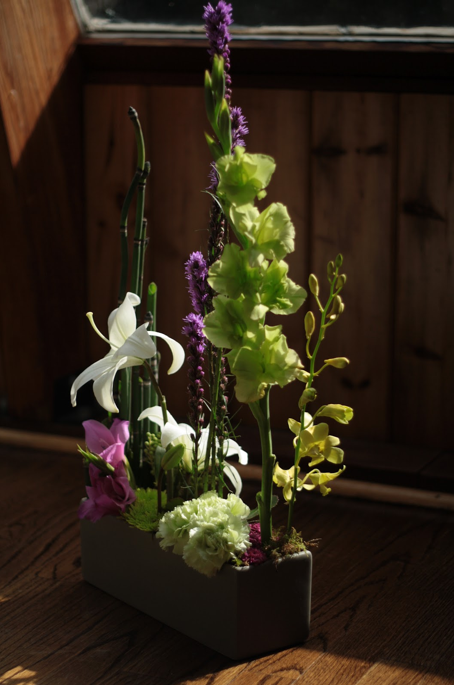There was overlap with Advanced and Basic this past week. But this was the last Basic class, boo hoo! I never wanted it to end. In today’s class we reviewed the principles and elements of design, and then did 2 arrangements. The first was a simple market bouquet in glass, taken apart and re-designed with added greens and a few extra flowers. I think we’ve all had experience with this- you bring home a bouquet from the grocery store and you can’t just stick it into a vase “as-is.” You need to break all the stems into groups and analyze what you have. Often the bouquet from the market has the different flowers placed in a very regular pattern all around – but maybe you’d like it better and there would be more impact if some of the flowers were grouped together. This was quick and easy but important as it was our first design in glass with water – no Oasis! So how will the stems stay in place? We had a few options for the mechanics – the first was to create a grid out of clear tape, creating 1″ holes on a dry vase and running tape all around the rim once finished.
The second, and the one I went for as it would create interest in the lower half of the arrangement, was the branch structure with willow. Wrap a stem of curly willow around your hand and smush it into the glass, adding a few big stems in a criss cross pattern for more support, and 2-4 more wrapped stems as needed. You could use any other flexible stems for this, like red stemmed dogwood for example. Just make sure they’re pretty bendy.
Personally I know I will use this method again, it was really easy to work with – the stems stayed put – and I really liked the way it looked especially after you put water into the design. Of course there are many other ways to support stems in water – by using kenzans/frogs/pin holders, or using foliage or large flowers at the base to keep other flowers stable.
Next up, the one flower/one foliage stem design in glass. We were given a glass cylinder vase and a quick demo from instructor Jane on some unique things you can do to various foliage stems to create drama. Here she’s wired Equisetum to get it to conform to the shape she wants – a long rectangle – that will contain the single lily flower like a frame. She’s also revealed a very important trick of the trade – called U-Glu dashes which are tiny dots of clear tacky glue that can help stems stay put and so much more.
In a flower show competition, none of the mechanics should be visible unless they are purposefully part of the design, like using bind wire repetitively around a wrapped stem. As she’s doing her demo, I already have an idea for what I want to do, using Phormium or Flax, and one single Anthurium. And because the practice of sketching has been pressed into my brain from the Advanced class, I do a quick sketch of a possible arrangement.
Of course, once you start working with the plant material, it might tell you it wants to do something else, which it did in my design. First I wound the phormium leaf in a spiral around my hand, and sunk it into the container. I fussed with the spacing and at the top used a bit of U-Glu to adhere it to the vase. Then, I tried wiring the anthurium because I wanted to to be taller and I wanted to play with it’s form, but that was harder than it looked and I couldn’t get the wire all the way up the stem, so to disguise the wire sticking out at the bottom, I wrapped another phormium leaf around the stem and then bound the whole thing with bind wire in a hopefully decorative way.
What was so amazing about this class was again the hugely varied results given that we all had similar material to work with, and all the same vase. Jane gave us big kudos and we all felt very good about ourselves!

here all the lily designs are grouped together, giving us the idea that you could create sets of these designs for an event - getting a lot of 'bang for your buck'

one tulip, poked through a flax leaf. i also loved jenny's design using willow and a tulip but didn't get a good pic. sorry!
I will miss all the great students of this class! Hope to see you in Basic II in the fall. And thanks, Jane, for getting me hooked on Floral Design.



































































